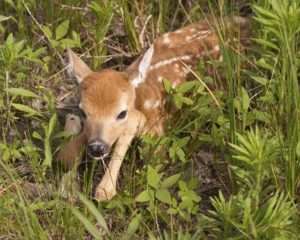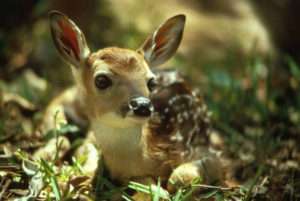My previous two posts dealt with what to do if you find a baby bird or baby rabbit. This week I’m going to complete the “commonly kidnapped baby animals” trifecta with baby deer. All three may be found unattended in spring and early summer, and unfortunately many end up dying because well-meaning people separate them from their parents intending to care for them themselves, or taking them to a wildlife rehab. Even under the best of professional care many baby animals are simply too fragile, and like the other animals, if you’ve found a baby deer it’s best to leave the care to mama.
A Little About Fawns
 A fawn is simply a young deer, particularly one that hasn’t been weaned from its mother yet. North America has several species of deer, though the young of white-tailed deer (Odocoileus virginianus), Columbian black-tailed deer (Odocoileus hemionus columbianus), Sitka deer (Odocoileus hemionus sitkensis) mule deer (Odocoileus hemionus) and Yucatan brocket deer (Odocoileus pandora) are the most likely to be known as fawns. The young of other deer like elk (Cervus canadensis) and moose (Alces alces) are more commonly called calves. There are also a few non-native species of deer raised on meat/hunting farms like fallow deer (Dama dama) and axis deer (Axis axis), but you’re not as likely to run into these in the wild unless a few have escaped from nearby farms.
A fawn is simply a young deer, particularly one that hasn’t been weaned from its mother yet. North America has several species of deer, though the young of white-tailed deer (Odocoileus virginianus), Columbian black-tailed deer (Odocoileus hemionus columbianus), Sitka deer (Odocoileus hemionus sitkensis) mule deer (Odocoileus hemionus) and Yucatan brocket deer (Odocoileus pandora) are the most likely to be known as fawns. The young of other deer like elk (Cervus canadensis) and moose (Alces alces) are more commonly called calves. There are also a few non-native species of deer raised on meat/hunting farms like fallow deer (Dama dama) and axis deer (Axis axis), but you’re not as likely to run into these in the wild unless a few have escaped from nearby farms.
Fawns are generally born brown with white spots; these spots help with camouflage. While they are precocious and can walk within hours of birth, they won’t be able to keep up with their mother until they’re a few weeks old. Therefore, like rabbits, the doe leaves her young hidden in vegetation while she goes to graze and browse. She only returns to nurse them; if she has more than one fawn she often hides them separately, and visits each one in turn.
By about three months of age a fawn will have shed its spots and started to grow in a more adult coat. However, fawns stay with their mother for a while after; bucks will often leave after a year, while does may stick around for another year, even if the mother has a new fawn to care for. Even after the fawn is weaned from mother’s milk, it still has a lot to learn about living in the wild, something we humans can’t teach it.
Too many people find a baby deer curled up in the grass and assume it has been abandoned. Unfortunately, while wildlife rehabs do their best to care for fawns that are brought in, not all will thrive on formula. Moreover, if a fawn is the only deer at a given rehab facility, it’s easier for it to become habituated to humans and lose its fear of us; while these facilities try to keep the fawns in groups, if only one is currently in house there’s not much they can do for cervine socialization.
Why is this a problem? If deer lose their fear of humans they’re less likely to run away from hunters or avoid roads and housing. Those that have come to associate humans with food can become dangerously aggressive in seeking food from any human they meet. They also may be less hesitant to attack humans if they feel threatened, or during the fall rut. Those cute little baby fawns grow up into rather large deer; a mule deer buck, for example, can top out at over 300 pounds! And those antlers are serious business, too. Bucks and does alike can do some significant damage kicking and striking with sharp hooves. And just getting body-checked by an aggressive deer could result in severe injuries! Bambi is NOT your cute little forest friend.
In short, the less human handling a fawn gets when young, the less likely it is to run into problems–or be a problem itself–later on.
If You’ve Found a Baby Deer…
 Should you run across a fawn curled up in the grass, the best thing to do is give it plenty of space and keep moving. Don’t touch it, don’t pick it up, and don’t try to feed or move it. If you’re able to come back and check on it you can do so after a day or so, but chances are it’s going to be fine. If the fawn is thin and bony-looking, trembling, wet and cold, laying on its side instead of curled up, obviously injured, or has been calling for its mother without answer for a while, then it may need help. (The “curled ears” thing is not as simple as it’s been made out to be online, as per this article.)
Should you run across a fawn curled up in the grass, the best thing to do is give it plenty of space and keep moving. Don’t touch it, don’t pick it up, and don’t try to feed or move it. If you’re able to come back and check on it you can do so after a day or so, but chances are it’s going to be fine. If the fawn is thin and bony-looking, trembling, wet and cold, laying on its side instead of curled up, obviously injured, or has been calling for its mother without answer for a while, then it may need help. (The “curled ears” thing is not as simple as it’s been made out to be online, as per this article.)
Even if the fawn is distressed, your first action needs to be contacting your nearest wildlife rehab or state fish and game department and ask for advice. They may be able to determine whether the fawn is actually in need of help or not, especially if you’re able to text or email a photo, and they may want to come pick it up themselves as they have more experience. If they want you to bring it in, they’ll give you instructions on proper handling.
Under NO CIRCUMSTANCES should you attempt to care for a fawn yourself if you are not an experienced, licensed wildlife rehabilitator. Not only do you lack the skills and tools to give the fawn the best chance possible, but it is illegal to possess native wildlife without a permit. And I want to reiterate that the vast majority of the time, a found fawn is going to be better off under its mother’s care.
Finally, I want to end this the same way I did the other two articles, with a reminder that sometimes it’s best to let nature take its course. Many fawns don’t survive to adulthood in the wild, but instead become crucial sources of food for young coyotes, foxes, hawks, and other predatory species, as well as scavengers on clean-up duty. This is always the way things have been, and nothing is wasted in nature. If the fawn you’re about to kidnap is going to die anyway, let it be in a natural setting where its remains can benefit other young, growing animals rather than in the terrifying confines of a human facility.
